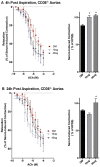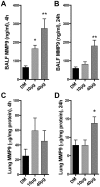MMP-9-Dependent Serum-Borne Bioactivity Caused by Multiwalled Carbon Nanotube Exposure Induces Vascular Dysfunction via the CD36 Scavenger Receptor
- PMID: 26801584
- PMCID: PMC4966280
- DOI: 10.1093/toxsci/kfw015
MMP-9-Dependent Serum-Borne Bioactivity Caused by Multiwalled Carbon Nanotube Exposure Induces Vascular Dysfunction via the CD36 Scavenger Receptor
Abstract
Inhalation of multiwalled carbon nanotubes (MWCNT) causes systemic effects including vascular inflammation, endothelial dysfunction, and acute phase protein expression. MWCNTs translocate only minimally beyond the lungs, thus cardiovascular effects thereof may be caused by generation of secondary biomolecular factors from MWCNT-pulmonary interactions that spill over into the systemic circulation. Therefore, we hypothesized that induced matrix metalloproteinase-9 (MMP-9) is a generator of factors that, in turn, drive vascular effects through ligand-receptor interactions with the multiligand pattern recognition receptor, CD36. To test this, wildtype (WT; C57BL/6) and MMP-9(-/-)mice were exposed to varying doses (10 or 40 µg) of MWCNTs via oropharyngeal aspiration and serum was collected at 4 and 24 h postexposure. Endothelial cells treated with serum from MWCNT-exposed WT mice exhibited significantly reduced nitric oxide (NO) generation, as measured by electron paramagnetic resonance, an effect that was independent of NO scavenging. Serum from MWCNT-exposed WT mice inhibited acetylcholine (ACh)-mediated relaxation of aortic rings at both time points. Absence of CD36 on the aortic rings (obtained from CD36-deficient mice) abolished the serum-induced impairment of vasorelaxation. MWCNT exposure induced MMP-9 protein levels in both bronchoalveolar lavage and whole lung lysates. Serum from MMP-9(-/-)mice exposed to MWCNT did not diminish the magnitude of vasorelaxation in naïve WT aortic rings, although a modest right shift of the ACh dose-response curve was observed in both MWCNT dose groups relative to controls. In conclusion, pulmonary exposure to MWCNT leads to elevated MMP-9 levels and MMP-9-dependent generation of circulating bioactive factors that promote endothelial dysfunction and decreased NO bioavailability via interaction with vascular CD36.
Keywords: CD36; MMP-9.; carbon nanoparticle; cardiovascular; serum; toxicity; vascular.
© The Author 2016. Published by Oxford University Press on behalf of the Society of Toxicology. All rights reserved. For Permissions, please e-mail: journals.permissions@oup.com.
Figures







References
-
- Aird W. C. (2008). Endothelium in health and disease. Pharmacol. Rep. 60, 139–143. - PubMed
-
- Alheid U., Frolich J. C., Forstermann U. (1987). Endothelium-derived relaxing factor from cultured human endothelial cells inhibits aggregation of human platelets. Thromb. Res. 47, 561–571. - PubMed
-
- Bai N., van Eeden S. F. (2013). Systemic and vascular effects of circulating diesel exhaust particulate matter. Inhal. Toxicol. 25, 725–734. - PubMed
-
- Bai N., Khazaei M., van Eeden S. F., Laher I. (2007). The pharmacology of particulate matter air pollution-induced cardiovascular dysfunction. Pharmacol. Ther. 113, 16–29. - PubMed
Publication types
MeSH terms
Substances
Grants and funding
LinkOut - more resources
Full Text Sources
Other Literature Sources
Medical
Miscellaneous

